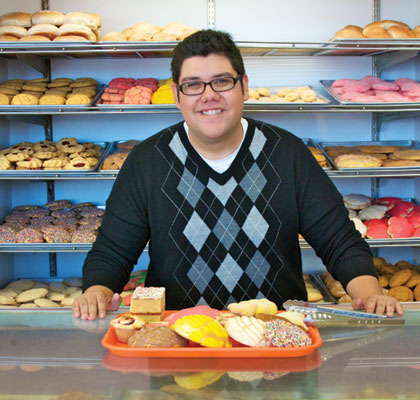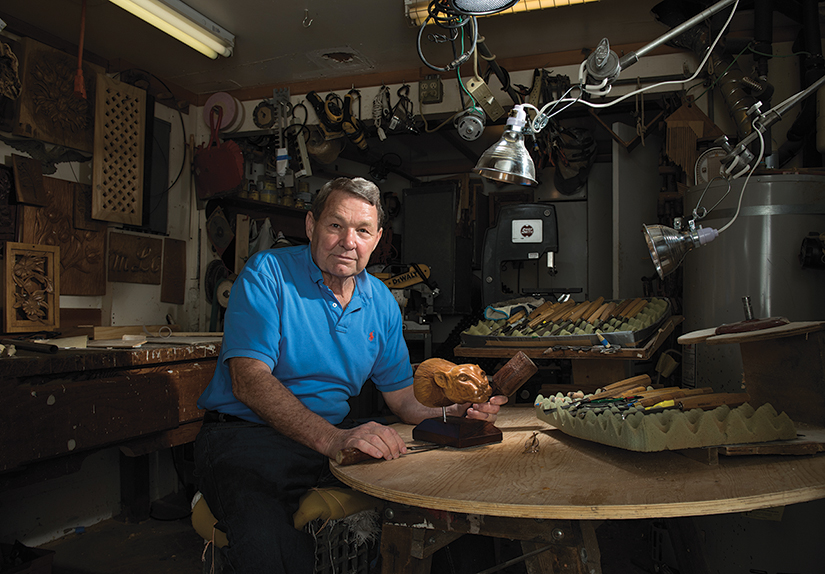
Transformational Talent
Meet five talented local artists. Each has a unique and remarkable vision, which fuels creative impulses inspired by ordinary objects the rest of us overlook. Viewing their work is to glimpse a magical, amazing world where the mundane transforms into the extraordinary and takes on new meaning.
-
CategoryPeople
-
Written byAnne M. Russell |
Dennis Skinner, Wood-carver, Cabinetmaker
Dennis Skinner spent his career as a commercial food photographer but now retired, he can follow his true passion: furniture building and wood carving. Since starting woodcraft as a hobby in his 30s, he’s taken a few master classes but is mostly self-taught. And yes, he’s had some close calls with electric saws but still has all 10 fingers.
He works in a modest, but well-equipped, shop under his home in Studio City. His material of choice is pine although Dennis also uses basswood (linden) and black walnut. “I’ve always got my eye open for something that looks like I could carve it,” he says of his search for inspiration. His fascination with entwined grapevines began while visiting Florence, Italy, where he spotted a grape-themed panel on the outer doors of the city’s cathedral.
Dennis always begins by making a small test piece. He doesn’t carve from a single block of wood. His magnum opus, a nearly life-size flying eagle, is made of several finished pieces glued together including two separate wings, epoxy feet and bone claws. He keeps meticulous track of the hours he invests in each work; by his calculations, he’s put 200 hours into this one. “It’s thousands of little tiny cuts,” he says. “I don’t like to start unless I can spend four to five hours.”
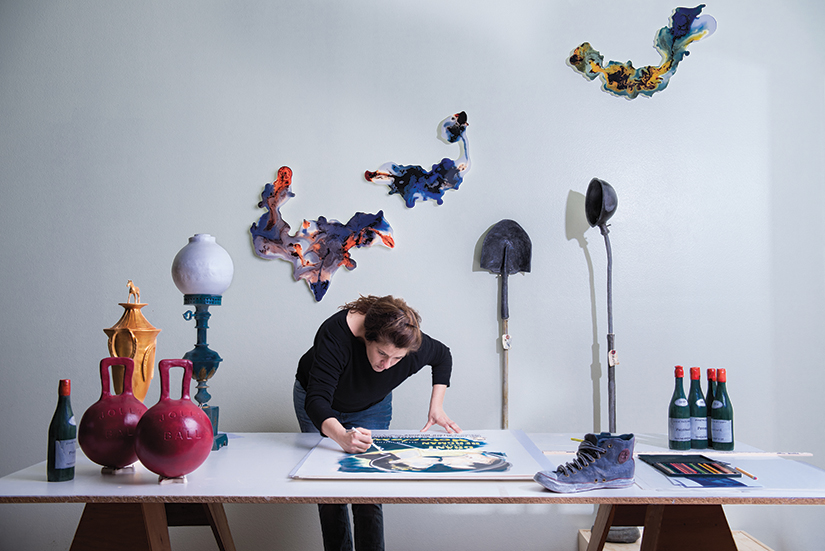 Gioj De Marco, Sculptor, Multimedia Artist
Gioj De Marco, Sculptor, Multimedia Artist
For Gioj De Marco, whose first name is pronounced “Joy,” becoming an artist was a gradual process. She moved from Luxembourg to LA at age 18 with vague plans to act, but slowly gravitated toward making art. “One day you wake up and you’re an artist,” she says. “You do artist things and you live an artist lifestyle.” That’s not to say she lacks credentials; Gioj holds a BFA from Cal State Long Beach, an MFA from Cranbrook Academy of Art in Michigan and speaks five languages.
Now living and working in her multi-level studio in Chatsworth, Gioj is also an adjunct professor at Cal State University, Northridge. Her current project, “Plot Coupons,” involves sculpting replicas of key props from Alfred Hitchcock films—his so-called MacGuffins. Made of a mixture of unfired clay and paper, the true-to-scale artworks include the wine bottles from Notorious, ski poles from Spellbound, and cymbals from The Man Who Knew Too Much.
She begins creating by sketching and experimenting in her dry studio. “I’ve got to have a plan,” she says. “I am not a stream-of-consciousness artist.” She then moves to her wet studio to build the replicas coil-and-slab style, typically over a two-to-three-week period, creating a fragile, unique sculpture referencing an expendable background item. “There’s something really touching about the public history these objects represent,” she says.
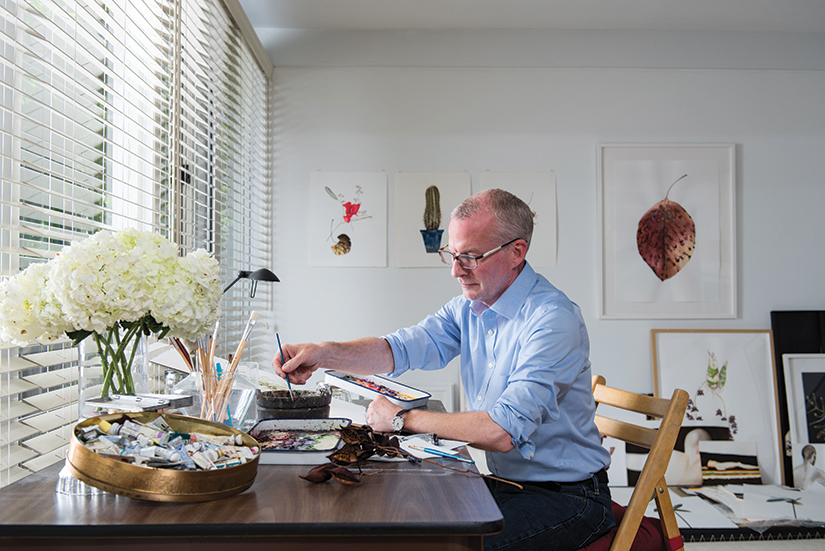 Parnell Corder, Botanical Watercolorist
Parnell Corder, Botanical Watercolorist
Parnell Corder has known he was an artist since he was six years old. “I had a moment where I decided,” he says. “It was a very distinctive experience.” He grew up in Indianapolis, later studying at the Art Institute of Chicago. He has lived in California for the last two decades—the most recent 12 years in Sherman Oaks. His bright, book-lined studio is in his home, an Edward Fickett ranch house from the 60s.
Parnell says he is sometimes asked if he is a botanist, but he is not; he is a self-taught botanical painter. His fascination with plants and flowers is not for their taxonomy, but for their shape and structure. “I’m drawn to the elegantly gnarled,” he says. He may find a dried seedpod or a curled leaf during one of his walks off Mulholland where the pavement becomes parkland, or choose an orchid from his small backyard garden. As he paints in watercolor, he stops to examine the details of his subject with a magnifying glass or to photograph the work in progress to get a new perspective.
Parnell works quickly, sometimes completing a small, 8-by-10-inch painting in four to five hours. Some of his work is commissioned, such as his studies of prize-winning orchids. Viewing his orchid creations, it is not surprising to learn he has won awards for them. He snagged first place in 2014 at the Santa Barbara International Orchid Exhibition.
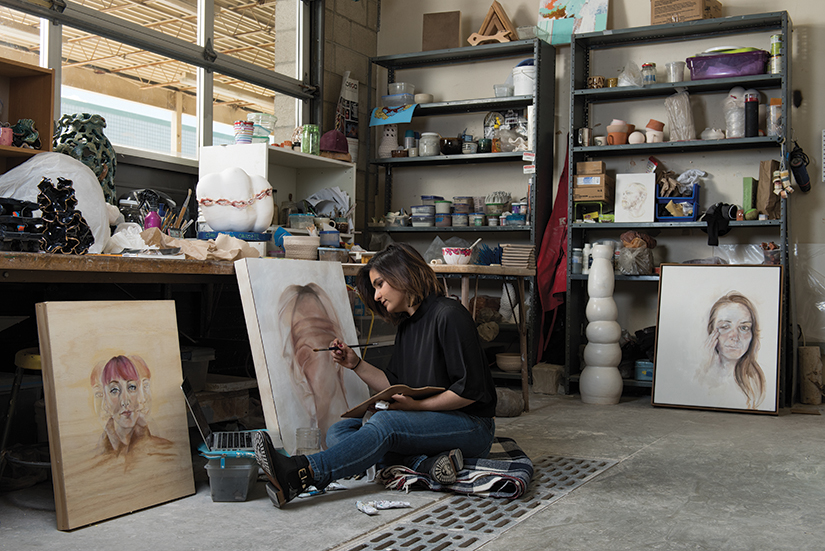 Alexsandra Papoban, Painter, Ceramist
Alexsandra Papoban, Painter, Ceramist
Until she was nine years old, Alexsandra Papoban didn’t realize she sees the world differently. It’s not that she found her artistic vision early; she has a visual defect known as amblyopia, where the optic nerve doesn’t communicate well with the brain. “I always saw this ghost image,” she says.
In her teens Alexsandra began making portraits—playing with that ghost image. Now as a 24-year-old grad student at Cal State University, Northridge, her work focuses on the intersection of art and human anatomy. Both on canvas and in ceramics, she explores the fragility of the eye. In fact, that awareness of vulnerability is at the core of her efforts. “Ceramics is so thrilling,” she says. “Painting on something so fragile is exciting.”
She works in her tiny corner of a six-person shared studio or in CSUN’s classrooms or kiln area, as many as 16 hours a day. Her fired-ceramic pieces are intricate.“Three hours will go by and I will only have done an inch of work,” she says. When she paints, she usually starts with acrylic to define the image and then finishes it in oil. She uses photos she’s taken of people for reference, sometimes manipulating the images in Photoshop to create effects she wants to capture. “In my head, I’d like to finish in a week,” she says. “As an artist, you have to teach yourself when you’re done.”
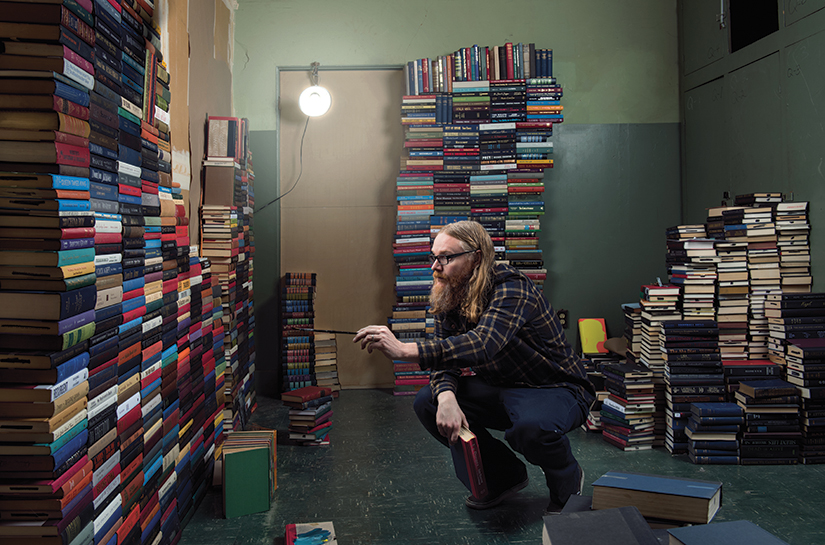 Mike Stilkey, Painter, Book Sculptor
Mike Stilkey, Painter, Book Sculptor
Mike Stilkey grew up in and around the Valley in the ‘80s, but not happily, due to a troubled family life. “Art was an escape for me,” he says. “I was a terrible artist, but I loved making art.” History, however, suggests Mike was somewhat of a prodigy since his very first show, held while he was in his 20s, sold out.
His paintings and especially his painted-book sculptures continue to be very popular, attracting commissions and invitations for installations all over the world. He’s currently working on a big project for the iPic movie theater chain; his next large book sculpture and accompanying paintings will soon go into iPic’s Westwood location.
Working from his spacious converted garage in Sierra Madre, Mike’s inspiration comes from within: “I work with a feeling,” he says. “A lot of the time I’ll just start painting and let what’s happening happen.” In addition to stacks of discarded books, the garage contains a pool table and Mike is a top-ranked competitor in the game. He’ll work on a painting somewhere between a day and week. “Usually the ones that take a day are the best,” he says. He paints with acrylic because, he explains, “I’m too impatient to work in oil.”
Architect May Sung Comes to The Rescue on a Studio City Reno Gone Wild
In the right hands…finally!









